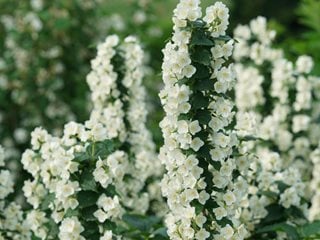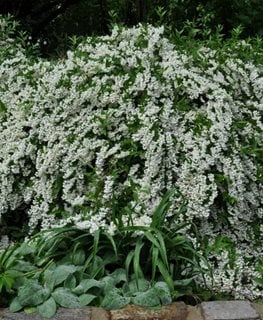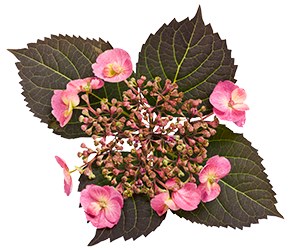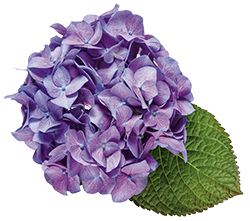Growing Mock Orange Shrubs: Planting, Caring, & Pruning Tips
Prized for their intoxicating fragrance, these old-fashioned garden shrubs are better than ever thanks to many new cultivars.With its frilly spring flowers and heady scent reminiscent of orange blossoms, mock orange bushes have long been a cottage garden favorite. But if you are only familiar with the large shrubs from your grandmother’s garden, you may have assumed they offered little ornamental value once their flowers and trademark fragrance faded. That may have been true 20 years ago, but not today.
In recent years, plant breeders have given mock oranges a makeover, developing cultivars with tidier growth habits and more colorful foliage. Many are also smaller, so they won’t overtake your garden beds and borders. Perhaps the biggest breakthrough is one that reblooms in summer, giving you another opportunity to enjoy its floral beauty and sweet perfume.
On this page: Basics | Planting | Care & Pruning | Mock Orange Pictures | Garden Uses
THE BASICS
Botanical name:
Philadelphus spp. (not to be confused with Pittosporum, also commonly called mock orange)
Common names:
Mock orange, mockorange, sweet mock orange
Plant Type:
Deciduous shrub
Hardiness zones:
Typically 4-8, although some varieties can tolerate colder climates.
Height and spread:
3 to 10 feet tall and wide
Bloom time:
Late spring to early summer, with the flowers lasting 4 to 6 weeks.
Flower characteristics:
White flowers, single or double, 1 to 2 inches across. All are fragrant, but the intensity can vary depending on the cultivar.
Foliage:
Oval, with smooth or serrated edges. Usually dark green in color, but some newer cultivars have leaves that are golden yellow or variegated.
Special attributes:
Deer resistant, drought tolerant, pest resistant. The fragrant blooms are magnets for pollinators.
PLANTING MOCK ORANGE
Where to plant:
In full sun or partial shade, in fertile, well-drained soil. Consider planting in a spot where the scent can be fully appreciated, such as adjacent to a walkway or patio.
When to plant:
Midfall or early spring
How to plant:
Place in a hole twice as wide as the root ball and deep enough so the top of the root ball is level with the soil surface. Water thoroughly after planting. Amending the soil with compost or another organic material before planting will help to improve soil fertility.
Plant spacing:
Space accordingly, depending on the size at maturity, to allow for good air circulation and so that plants won't require too much pruning to keep them in bounds.
MOCK ORANGE PRUNING & CARE
Pruning:
Because mock oranges bloom from buds that develop on the previous year’s growth (old wood), prune them in early summer immediately after they have finished flowering to maintain their shape. Overgrown shrubs can be cut back more dramatically, but they may not develop flowers the next season.
Water requirements:
Keep newly planted shrubs well watered, especially during the heat of the summer, but don't let the soil become soggy. Once plants are established, they can tolerate short periods of drought. Cover the area around your shrubs with a layer of mulch to help retain soil moisture and minimize water use.
Fertilizing:
They usually don’t need supplemental fertilizer, especially when grown in nutrient-rich soil. However, they can benefit from the application of a layer of compost in the spring and the use of a well-balanced fertilizer formulated for flowering shrubs. Avoid using fertilizers high in nitrogen, which can prevent blooming.
Pests and diseases:
There are few insect or disease problems, but it can develop leaf spot and powdery mildew, especially when exposed to overly wet, humid conditions. Aphids, leaf miners, and spider mites may also become a nuisance, but are rarely serious threats.
MOCK ORANGE PICTURES
GARDEN USES
Use mock orange bushes as specimen plants, massed along a border, or as a loose privacy hedge. Smaller cultivars work well in perennial gardens and can also be grown in containers. Excellent for cut flowers.
RELATED:
Shrubs 101
Flowering Shrubs
17 Fast-Growing Shrubs for Your Garden
20 Fragrant Flowering Plants
10 Ways to Start Building a Garden for Wildlife
Growing Indian Hawthorn Shrubs














